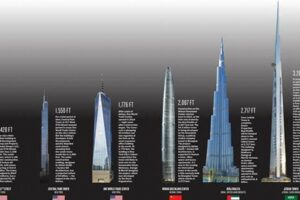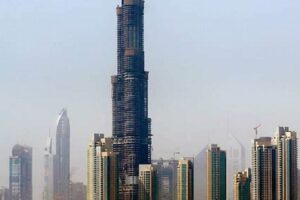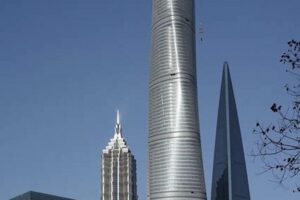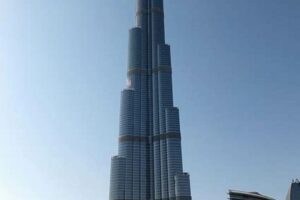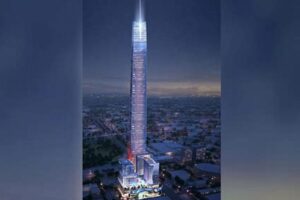How many feet is the tallest skyscraper? The answer to this question depends on the specific skyscraper in question, as there are many tall skyscrapers around the world. However, as of 2023, the tallest skyscraper in the world is the Burj Khalifa in Dubai, United Arab Emirates, which stands at 2,717 feet (828 meters) tall.
Skyscrapers are important for a number of reasons. They can provide much-needed office space in dense urban areas, and they can also be used to house residential units, retail stores, and other amenities. Skyscrapers can also be iconic landmarks that define a city’s skyline and attract tourists from around the world.
The history of skyscrapers dates back to the late 19th century, when the first tall buildings were constructed in Chicago and New York City. Over the years, skyscrapers have become increasingly tall and sophisticated, and they are now a common sight in major cities around the world.
1. Height
The height of a skyscraper is one of its most important features. It is what makes a skyscraper stand out from other buildings and what makes it a symbol of power and prestige. The height of a skyscraper can also be a major factor in its design and construction costs.
The tallest skyscraper in the world is the Burj Khalifa, which stands at 2,717 feet (828 meters) tall. The Burj Khalifa’s height is a major factor in its design. The building’s core is made of reinforced concrete, and its exterior is made of glass and steel. The Burj Khalifa also has a number of wind turbines that help to generate electricity for the building.
The height of a skyscraper can also be a major factor in its construction costs. The taller a skyscraper is, the more materials and labor are required to build it. The Burj Khalifa’s construction costs were estimated to be around $1.5 billion.
Despite the challenges, the height of a skyscraper can also be a major benefit. A taller skyscraper can provide more office space, residential units, and other amenities. A taller skyscraper can also be a more iconic landmark and a more attractive investment.
2. Structure
The structure of a skyscraper is one of the most important factors that determines its height. A skyscraper must be able to withstand the forces of gravity, wind, and earthquakes, and its structure must be strong enough to support the weight of the building and its occupants.
- Core
The core of a skyscraper is its central load-bearing structure. The core is typically made of reinforced concrete or steel, and it is designed to resist the forces of gravity and wind. The core also houses the building’s elevators, stairwells, and other essential services.
- Exterior walls
The exterior walls of a skyscraper are designed to protect the building from the elements and to provide insulation. The exterior walls are typically made of glass, metal, or concrete, and they are often designed to be aerodynamic to reduce wind resistance.
- Floors
The floors of a skyscraper are typically made of concrete or steel, and they are designed to support the weight of the building’s occupants and furnishings. The floors are also designed to be fire-resistant and to provide sound insulation.
- Roof
The roof of a skyscraper is designed to protect the building from the elements and to provide insulation. The roof is typically made of concrete or metal, and it is often designed to be aerodynamic to reduce wind resistance.
The structure of a skyscraper is a complex and challenging engineering task. However, by carefully designing and constructing the building’s structure, engineers can create skyscrapers that are both tall and safe.
3. Location
The location of a skyscraper is one of the most important factors that determines its height. Skyscrapers are typically built in dense urban areas, where land is scarce and expensive. This means that the taller a skyscraper is, the more valuable the land it is built on.
For example, the Burj Khalifa, the tallest skyscraper in the world, is located in Dubai, United Arab Emirates. Dubai is a major financial center, and the Burj Khalifa is a symbol of the city’s wealth and power. The building is located on a prime piece of land in the city center, and its height gives it a commanding view of the city skyline.
The location of a skyscraper can also affect its design. For example, skyscrapers that are built in areas with high winds must be designed to withstand the additional forces. Skyscrapers that are built in areas with earthquakes must be designed to withstand the shaking. The location of a skyscraper can also affect its construction costs. Skyscrapers that are built in areas with difficult soil conditions may require more expensive foundations.
Overall, the location of a skyscraper is a critical factor that determines its height, design, and construction costs.
4. Purpose
The purpose of a skyscraper is one of the most important factors that determines its height. Skyscrapers are typically built for one of three main purposes: office space, residential units, or a combination of both. The tallest skyscrapers in the world are typically built for office space, as this type of use generates the most revenue. For example, the Burj Khalifa, the tallest skyscraper in the world, is primarily used for office space.
- Office space
Skyscrapers that are built for office space are typically designed to maximize the amount of rentable space. This means that the buildings are typically very tall and have a large floor plate. The Burj Khalifa, for example, has a floor plate of over 30,000 square meters.
- Residential units
Skyscrapers that are built for residential units are typically designed to provide a high quality of living for their occupants. This means that the buildings typically have a variety of amenities, such as swimming pools, fitness centers, and concierge services. The Burj Khalifa, for example, has over 1,000 residential units, and it offers a wide range of amenities to its residents.
- Mixed-use
Skyscrapers that are built for mixed-use purposes typically combine office space and residential units. This type of building is becoming increasingly popular, as it allows developers to maximize the value of their land. The Burj Khalifa, for example, is a mixed-use building that contains both office space and residential units.
The purpose of a skyscraper is a critical factor that determines its height, design, and construction costs. By understanding the purpose of a skyscraper, we can better understand why it was built and how it is used.
5. Design
The design of a skyscraper is one of the most important factors that determines its height. The building’s structure, exterior walls, floors, and roof must all be carefully designed to withstand the forces of gravity, wind, and earthquakes. The building’s design must also be efficient and cost-effective.
- Structural design
The structural design of a skyscraper is critical to its ability to withstand the forces of gravity, wind, and earthquakes. The building’s core, exterior walls, floors, and roof must all be strong enough to support the weight of the building and its occupants. The building’s structural design must also be flexible enough to withstand the swaying caused by wind and earthquakes.
- Exterior design
The exterior design of a skyscraper is important for both aesthetic and functional reasons. The building’s exterior must be able to withstand the elements and protect the building’s occupants from the sun, wind, and rain. The exterior design must also be aerodynamic to reduce wind resistance.
- Interior design
The interior design of a skyscraper is important for creating a comfortable and efficient work environment for the building’s occupants. The interior design must also be flexible enough to accommodate the changing needs of the building’s tenants.
- Sustainable design
The sustainable design of a skyscraper is important for reducing the building’s environmental impact. The building’s design should incorporate energy-efficient features, such as LED lighting and solar panels. The building should also be designed to minimize water consumption and waste production.
The design of a skyscraper is a complex and challenging task. However, by carefully considering all of the factors involved, architects and engineers can create skyscrapers that are both tall and safe.
6. Construction
The construction of a skyscraper is a complex and challenging process. It requires careful planning, engineering, and execution. The construction process can take several years to complete, and it can cost billions of dollars.
The first step in the construction process is to excavate the site and lay the foundation. The foundation is the most important part of the skyscraper, as it must be able to support the weight of the entire building. The foundation is typically made of concrete and steel, and it is sunk deep into the ground.
Once the foundation is in place, the steel framework of the skyscraper can be erected. The steel framework is made of beams and columns, and it forms the basic structure of the building. The steel framework is then covered with exterior walls, which can be made of glass, metal, or concrete.
The next step is to install the mechanical, electrical, and plumbing systems. These systems are essential for the operation of the skyscraper, and they include things like elevators, heating and cooling systems, and water and sewer lines.
Once the mechanical, electrical, and plumbing systems are in place, the interior of the skyscraper can be finished. The interior finishings can include things like drywall, paint, and flooring. The interior finishings are typically designed to meet the specific needs of the building’s tenants.
The construction of a skyscraper is a complex and challenging process, but it is also a necessary one. Skyscrapers are essential for providing office space, residential units, and other amenities in dense urban areas. By understanding the construction process, we can better appreciate the challenges involved in building these iconic structures.
7. Cost
The cost of constructing a skyscraper is one of the most important factors that determines its height. The taller a skyscraper is, the more it costs to build. This is because taller skyscrapers require more materials, labor, and engineering expertise. For example, the Burj Khalifa, the tallest skyscraper in the world, cost an estimated $1.5 billion to build.
The cost of constructing a skyscraper is also affected by the location of the building. Skyscrapers that are built in dense urban areas, where land is scarce and expensive, tend to cost more to build than skyscrapers that are built in less densely populated areas. For example, the cost of constructing a skyscraper in Manhattan, New York City, is much higher than the cost of constructing a skyscraper in a smaller city.
The cost of constructing a skyscraper also affects its design. Taller skyscrapers require more complex structural designs, which can increase the cost of construction. For example, the Burj Khalifa’s unique design, which includes a series of setbacks, required a more complex structural design than a more traditional skyscraper design.
Understanding the relationship between cost and height is essential for developers and architects who are planning to build skyscrapers. By carefully considering the cost of construction, developers and architects can design and build skyscrapers that are both tall and affordable.
8. Impact
The impact of skyscrapers on the surrounding environment is a complex and multifaceted issue. On the one hand, skyscrapers can provide much-needed office space and residential units in dense urban areas. They can also be iconic landmarks that define a city’s skyline and attract tourists from around the world. On the other hand, skyscrapers can also have a negative impact on the environment, by contributing to air pollution, traffic congestion, and noise pollution. They can also cast long shadows that can block sunlight from reaching street level, and they can create wind tunnels that can make it uncomfortable for pedestrians.
The height of a skyscraper can have a significant impact on its environmental impact. Taller skyscrapers require more materials and energy to construct, and they can also have a greater impact on wind patterns and sunlight. For example, the Burj Khalifa, the tallest skyscraper in the world, is estimated to have consumed over 1 billion kilowatt-hours of electricity in its first year of operation. This is equivalent to the annual electricity consumption of a small city.
However, the impact of a skyscraper is not solely determined by its height. The design of the building, the materials used, and the way it is operated can all have a significant impact on its environmental footprint. For example, skyscrapers that are designed to be energy-efficient and that use sustainable materials can have a much lower impact on the environment than skyscrapers that are not. Similarly, skyscrapers that are located in areas with good public transportation and that have bike-friendly amenities can help to reduce traffic congestion and air pollution.
Overall, the impact of skyscrapers on the surrounding environment is a complex issue that depends on a variety of factors. However, by carefully considering the design, construction, and operation of skyscrapers, it is possible to minimize their negative impact and maximize their positive impact.
9. Future
The future of skyscrapers is an exciting topic that is constantly evolving. As technology advances and new materials are developed, architects and engineers are able to design and build taller and more innovative skyscrapers. Some of the key trends that are likely to shape the future of skyscrapers include:
- Sustainability
Skyscrapers are becoming increasingly sustainable as architects and engineers focus on reducing their environmental impact. This includes using sustainable materials, incorporating energy-efficient features, and designing buildings that can withstand the effects of climate change.
- Mixed-use developments
Skyscrapers are increasingly being designed as mixed-use developments that include a variety of uses, such as office space, residential units, retail stores, and restaurants. This type of development allows people to live, work, and play in the same building, which can help to reduce traffic congestion and air pollution.
- Smart technology
Skyscrapers are becoming increasingly smart, with the integration of smart technology that can help to improve building efficiency, security, and comfort. For example, some skyscrapers are now equipped with sensors that can monitor air quality and adjust the building’s ventilation system accordingly.
- Vertical transportation
As skyscrapers continue to grow taller, the development of new and innovative vertical transportation systems is essential. These systems will need to be able to move people efficiently and safely to and from the upper floors of skyscrapers.
The future of skyscrapers is bright. As technology advances and new materials are developed, architects and engineers will be able to design and build even taller and more innovative skyscrapers. These skyscrapers will be more sustainable, more efficient, and more comfortable than ever before.
FAQs about “how many feet is the tallest skyscraper”
This section provides answers to some of the most frequently asked questions about the height of the tallest skyscraper.
Question 1: How many feet is the tallest skyscraper?
As of 2023, the tallest skyscraper in the world is the Burj Khalifa in Dubai, United Arab Emirates, which stands at 2,717 feet (828 meters) tall.
Question 2: How tall is the second tallest skyscraper?
The second tallest skyscraper in the world is the Shanghai Tower in Shanghai, China, which stands at 2,073 feet (632 meters) tall.
Question 3: How tall is the tallest skyscraper in the United States?
The tallest skyscraper in the United States is One World Trade Center in New York City, which stands at 1,776 feet (541 meters) tall.
Question 4: How tall is the tallest skyscraper in Europe?
The tallest skyscraper in Europe is the Lakhta Center in Saint Petersburg, Russia, which stands at 1,516 feet (462 meters) tall.
Question 5: How tall is the tallest skyscraper in the Southern Hemisphere?
The tallest skyscraper in the Southern Hemisphere is the Q1 Tower in Gold Coast, Australia, which stands at 1,058 feet (322 meters) tall.
Question 6: How tall will the next tallest skyscraper be?
The next tallest skyscraper is currently under construction and is expected to be completed in 2024. The building is called the Jeddah Tower and is expected to stand at 3,280 feet (1,000 meters) tall.
Summary: The tallest skyscraper in the world is constantly changing as new buildings are constructed. However, the Burj Khalifa has held the title of the tallest skyscraper in the world since its completion in 2010.
Transition to the next article section: The height of skyscrapers is a testament to the ingenuity and creativity of architects and engineers. As technology advances and new materials are developed, it is likely that even taller skyscrapers will be built in the future.
Tips Related to “how many feet is the tallest skyscraper”
The height of the tallest skyscraper is a fascinating topic that sparks curiosity and raises questions. Here are a few tips to help you explore this topic further:
Tip 1: Research different skyscrapers
There are many websites and resources that provide information on skyscrapers around the world. Explore these resources to learn about the different types of skyscrapers, their heights, and their locations. You can also find interesting facts and trivia about skyscrapers.
Tip 2: Visit a skyscraper
If you have the opportunity, visit a skyscraper in person. This will give you a firsthand experience of the scale and grandeur of these structures. You can also take a guided tour to learn more about the building’s design and construction.
Tip 3: Read books and articles about skyscrapers
There are many books and articles available that discuss the history, design, and construction of skyscrapers. Reading these materials will give you a deeper understanding of the topic and help you appreciate the complexity of these structures.
Tip 4: Watch documentaries about skyscrapers
There are also many documentaries available that explore the world of skyscrapers. These documentaries often provide stunning visuals and expert insights into the design and construction of these iconic structures.
Tip 5: Use Google Earth to explore skyscrapers
Google Earth is a great tool for exploring skyscrapers from anywhere in the world. You can use Google Earth to view different skyscrapers from different angles and perspectives. You can also use Google Earth to measure the heights of skyscrapers and compare them to other buildings.
Summary: The height of the tallest skyscraper is a testament to the ingenuity and creativity of architects and engineers. As technology advances and new materials are developed, it is likely that even taller skyscrapers will be built in the future.
Conclusion: By following these tips, you can learn more about the tallest skyscrapers in the world and appreciate the engineering marvels that they are.
Conclusion
The height of the tallest skyscraper is a testament to the ingenuity and creativity of architects and engineers. As technology advances and new materials are developed, it is likely that even taller skyscrapers will be built in the future. However, the height of a skyscraper is not the only measure of its success. Skyscrapers can also be judged by their design, their sustainability, and their impact on the surrounding community. The tallest skyscraper in the world may not always be the best skyscraper, but it is always a symbol of the human desire to reach for the sky.
The exploration of “how many feet is the tallest skyscraper” has led us to a deeper understanding of the history, design, and construction of these iconic structures. We have learned that skyscrapers are more than just tall buildings; they are symbols of innovation, ambition, and progress. As we continue to build taller and more innovative skyscrapers, we must never forget the human element that makes these structures possible. Skyscrapers are a testament to the power of human ingenuity, and they will continue to inspire and amaze us for generations to come.


